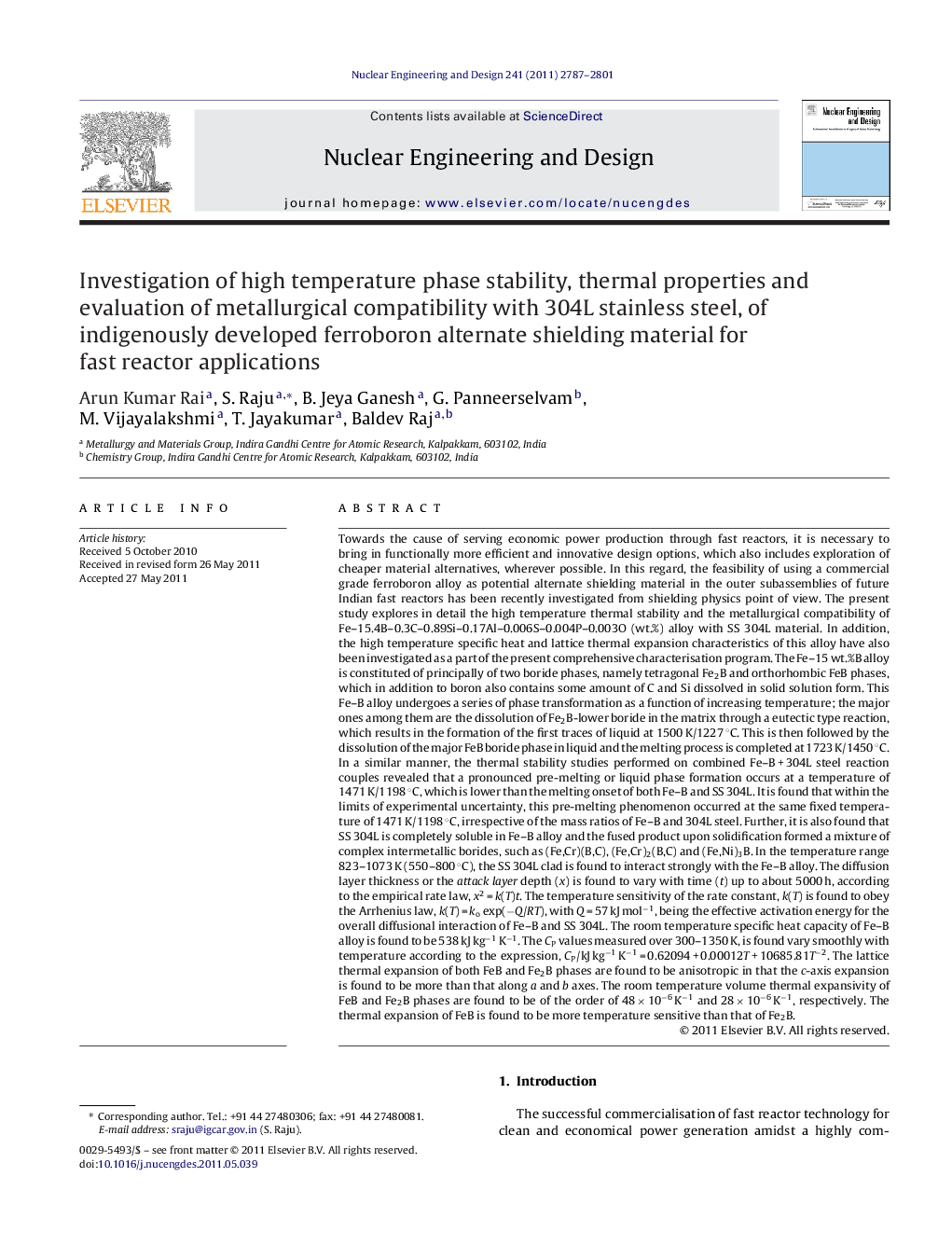| Article ID | Journal | Published Year | Pages | File Type |
|---|---|---|---|---|
| 297395 | Nuclear Engineering and Design | 2011 | 15 Pages |
Towards the cause of serving economic power production through fast reactors, it is necessary to bring in functionally more efficient and innovative design options, which also includes exploration of cheaper material alternatives, wherever possible. In this regard, the feasibility of using a commercial grade ferroboron alloy as potential alternate shielding material in the outer subassemblies of future Indian fast reactors has been recently investigated from shielding physics point of view. The present study explores in detail the high temperature thermal stability and the metallurgical compatibility of Fe–15.4B–0.3C–0.89Si–0.17Al–0.006S–0.004P–0.003O (wt.%) alloy with SS 304L material. In addition, the high temperature specific heat and lattice thermal expansion characteristics of this alloy have also been investigated as a part of the present comprehensive characterisation program. The Fe–15 wt.%B alloy is constituted of principally of two boride phases, namely tetragonal Fe2B and orthorhombic FeB phases, which in addition to boron also contains some amount of C and Si dissolved in solid solution form. This Fe–B alloy undergoes a series of phase transformation as a function of increasing temperature; the major ones among them are the dissolution of Fe2B-lower boride in the matrix through a eutectic type reaction, which results in the formation of the first traces of liquid at 1500 K/1227 °C. This is then followed by the dissolution of the major FeB boride phase in liquid and the melting process is completed at 1723 K/1450 °C. In a similar manner, the thermal stability studies performed on combined Fe–B + 304L steel reaction couples revealed that a pronounced pre-melting or liquid phase formation occurs at a temperature of 1471 K/1198 °C, which is lower than the melting onset of both Fe–B and SS 304L. It is found that within the limits of experimental uncertainty, this pre-melting phenomenon occurred at the same fixed temperature of 1471 K/1198 °C, irrespective of the mass ratios of Fe–B and 304L steel. Further, it is also found that SS 304L is completely soluble in Fe–B alloy and the fused product upon solidification formed a mixture of complex intermetallic borides, such as (Fe,Cr)(B,C), (Fe,Cr)2(B,C) and (Fe,Ni)3B. In the temperature range 823–1073 K (550–800 °C), the SS 304L clad is found to interact strongly with the Fe–B alloy. The diffusion layer thickness or the attack layer depth (x) is found to vary with time (t) up to about 5000 h, according to the empirical rate law, x2 = k(T)t. The temperature sensitivity of the rate constant, k(T) is found to obey the Arrhenius law, k(T) = ko exp(−Q/RT), with Q = 57 kJ mol−1, being the effective activation energy for the overall diffusional interaction of Fe–B and SS 304L. The room temperature specific heat capacity of Fe–B alloy is found to be 538 kJ kg−1 K−1. The CP values measured over 300–1350 K, is found vary smoothly with temperature according to the expression, CP/kJ kg−1 K−1 = 0.62094 + 0.00012T + 10685.81T−2. The lattice thermal expansion of both FeB and Fe2B phases are found to be anisotropic in that the c-axis expansion is found to be more than that along a and b axes. The room temperature volume thermal expansivity of FeB and Fe2B phases are found to be of the order of 48 × 10−6 K−1 and 28 × 10−6 K−1, respectively. The thermal expansion of FeB is found to be more temperature sensitive than that of Fe2B.
► High temperature phase stability and metallurgical compatibility of indigenous Ferro boron alloy (17 wt.%) with 304L SS have been evaluated using calorimetry, metallography and X-ray diffraction. ► Fe–B is stable upto 1227 °C without any phase transformation. ► In combination with SS 304L, it develops an eutectic reaction at 1198 °C. ► High temperature metallurgical interaction between Ferroboron and 304L SS clad has been simulated for temperatures 550–800 °C for reaction times up to 5000 h, using diffusion couple. ► Clad penetration depth with time follows a paraobolic rate law.
